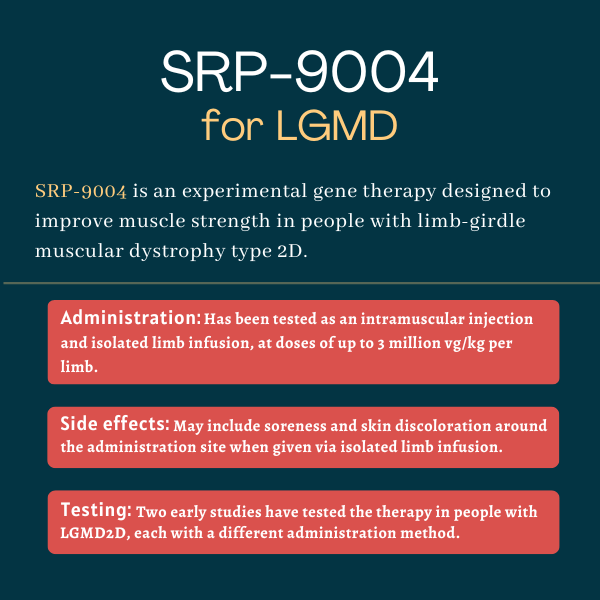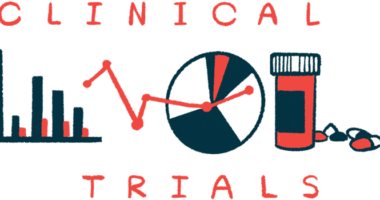SRP-9004 for limb-girdle muscular dystrophy
Last updated July 31, 2024, by Marisa Wexler, MS

What is SRP-9004 for limb-girdle muscular dystrophy type 2D?
SRP-9004 (patidistrogene bexoparvovec) is an experimental gene therapy designed to improve walking ability and muscle strength in people with limb-girdle muscular dystrophy (LGMD) type 2D.
The therapy has been given through intramuscular, or into-the-muscle, injections and via isolated limb infusion, a minimally invasive procedure used to deliver high doses of a medication exclusively to the blood supply of a designated limb.
It was originally developed as MYO-102 by Myonexus Therapeutics, but the company was acquired by Sarepta Therapeutics in 2019.
Therapy snapshot
| Treatment name: | SRP-9004 |
| Administration: | Has been given via intramuscular injections or isolated limb infusion |
| Clinical testing: | Completed a Phase 1 and a Phase 1/2 trial |
How does SRP-9004 work?
LGMD type 2D (LGMD2D), also known as LGMDR3, is a type of muscular dystrophy that’s caused by mutations in the SGCA gene, which provides instructions to make the alpha subunit of the sarcoglycan protein complex.
Normally located in the cellular membrane surrounding muscle cells, this complex helps maintain the structure of muscle tissue by binding to and stabilizing the dystrophin complex — which strengthens muscle fibers and protects them from injury as muscles contract and relax.
When the SGCA gene is mutated, cells cannot make enough of the functional alpha protein subunit. Ultimately, this means that the sarcoglycan complex cannot interact as intended with the dystrophin complex, and muscles are more fragile and easily damaged.
SRP-9004 is a gene therapy designed to deliver a healthy copy of the SGCA gene to muscle cells, allowing them to produce a functional alpha-sarcoglycan protein. This is expected to help the sarcoglycan complex assemble normally and interact with the dystrophin complex as it is supposed to, thereby slowing muscle damage.
The therapy is delivered via an adeno-associated virus, a harmless virus that’s been engineered to safely deliver specific genes to cells. The delivered genetic sequence also contains a region, called a promoter, to strongly promote gene activity specifically in muscle cells.
How will SRP-9004 be administered in LGMD?
In early clinical trials, SRP-9004 has been administered via an injection into a foot muscle, at a dose of 0.325 million vector genomes. It has also been given via a procedure called isolated limb infusion, at doses ranging from 1-3 trillion vector genomes per kilogram of body weight (vg/kg) per limb.
Originally developed to treat cancers that occur in the limbs, the procedure is designed to deliver a therapy to one limb’s blood supply, while the blood flow in and out of the limb is temporarily cut off.
Isolated limb infusion has been tested in SRP-9004 clinical trials because administering the gene therapy into the entire body’s blood circulation could increase the risk of toxic effects to vital organs. But researchers have noted that systemic (body-wide) administration may be needed to deliver the therapy to all muscles throughout the body and to achieve maximum clinical benefit.
More trials still are needed to determine the optimal administration method and dose that could be used if SRP-9004 ultimately is approved by regulatory authorities.

SRP-9004 in clinical trials
SRP-9004 has been tested in two early clinical trials, each involving six patients.
Phase 1 proof-of-concept study
SRP-9004 first was tested in a proof-of-concept Phase 1 clinical trial (NCT00494195) sponsored by the Nationwide Children’s Hospital. The study ran from 2008 through 2011, and included adults and children with LGMD2D, ages 5 and older.
All patients received a 0.325 mg dose, given via two-to-six injections into the extensor digitorum brevis, a small muscle in the foot that helps move the middle toes. In each patient, the muscle in one foot was injected with gene therapy, while the other foot was given a dummy injection as a control.
The first three patients were followed for up to three months, and all three had restored sarcoglycan expression. However, an increase in muscle fiber size after three months was noted in one participant, but not after six weeks in the other two patients.
Among the other three patients, who were followed for a longer period, two had sustained sarcoglycan expression after six months. The third patient had evidence of an immune reaction against the therapy’s viral vector, which likely contributed to the treatment’s reduced efficacy.
No adverse events were reported.
Phase 1/2 trial
Based on the sustained gene expression observed in the earlier trial, Sarepta launched a Phase 1/2 clinical trial (NCT01976091) that tested SRP-9004, delivered via isolated limb infusion, in six people with LGMD2D. The trial ran from 2015 to 2019.
The first patient, an adult who was no longer able to walk, received an infusion into one leg as a preliminary test of safety. The procedure was well tolerated overall, and data indicated that the gene therapy increased sarcoglycan expression and increased muscle strength in the knee of the targeted leg.
Then, five ambulatory children, ages 8 to 13, received the gene therapy in both legs at one of two doses (1 or 3 trillion vg/kg per limb). Biopsies showed sarcoglycan expression as intended.
Across two years of follow-up, two children, each receiving a different dose, lost the ability to walk independently. One child also experienced a decline in leg muscle strength.
Another two children, one also on the lower dose and one on the higher dose, had mostly stable walking ability, though measures of muscle strength decreased. The fifth child, who received the lower dose, experienced notable improvements in measures of muscle strength, though walking ability did not show any significant changes.
The therapy again was well tolerated overall, with no serious side effects reported.
Common side effects of SRP-9004
In early clinical trials, no side effects related to SRP-9004 itself were reported, regardless of its administration method. Among those who received it via isolated limb infusion, some patients experienced soreness and skin discoloration around the site where the therapy was administered.
Muscular Dystrophy News Today is strictly a news and information website about the disease. It does not provide medical advice, diagnosis, or treatment. This content is not intended to be a substitute for professional medical advice, diagnosis, or treatment. Always seek the advice of your physician or other qualified health provider with any questions you may have regarding a medical condition. Never disregard professional medical advice or delay in seeking it because of something you have read on this website.
Related articles






